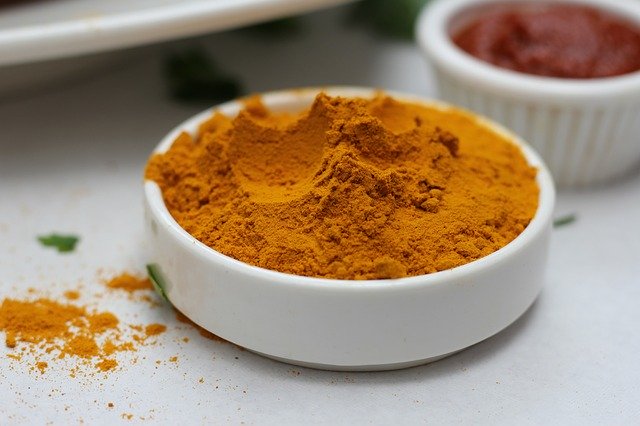
By Wen Liu • January 14, 2020
Do you wake up feeling creaky and stiff? Do your joints and muscles ache more than you think they should?
If you’re dealing with any of these things, there’s a pretty good chance you’re experiencing low-level chronic inflammation and turmeric may be able to help.
Turmeric is among the most studied natural herbs so the health benefits are backed by real peer-reviewed, scientific research.
Turmeric is a powerhouse of antioxidant nutrition that can help promote healthy functioning in your body and get you back on track.
What is Turmeric?

Before we launch into all the health benefits of turmeric, you might be wondering what it is.
Turmeric is a root spice that’s related to ginger root. It also looks kind of like ginger, with its light brown, gnarly root shape — that is, until you cut it open and discover the bright yellow or orange flesh inside.
You can find turmeric fresh in the produce departments of health food stores and Asian markets, but the fresh root is not as widely available as the dried powder.
Turmeric is most commonly used in Asian and Indian cuisine. It’s the ingredient in curry that makes it yellow, and the flavor profile is very distinct.
You can also use it to make tea or golden milk.
Golden milk is a delicious warm beverage primarily consisting of turmeric root and coconut milk. You can also add other delicious spices like ginger and cinnamon to spice up the flavor and up the antioxidant and antiinflammatory profile of this tasty beverage.
Drinking a turmeric beverage is a great way to ensure that you’re consuming turmeric every day.
Understanding Inflammation
We’ve mentioned inflammation a number of times at this point, so let’s get a better understanding of what it is and why you should be concerned about it.
Inflammation is a normal, natural function of the human body. It’s a feature, not a bug, of a properly functioning immune system.
Consider what happens when you cut yourself and don’t take care of the wound. Your skin gets warm to the touch, and the infected area turns red. This is your body’s way of protecting itself when bacterial invaders have entered that cut.
The same thing happens when you get sick.
If your system is infiltrated with bacteria or a virus, your immune system kicks in to fight. Sometimes you get a fever or sweats. That’s your body’s natural inflammatory response reacting in an acute and aggressive way to fight off infection.
So what’s wrong with inflammation?
Inflammation becomes a problem when it transitions from an acute response to a constant, chronic response.
In other words, a healthy immune system both turns on and turns off the inflammatory process. In an unhealthy system, the turning off process is short-circuited.
Chronic Inflammation
Chronic inflammation is the state of a constantly stimulated immune system and low-level inflammation of cells in the body.
It happens for a number of reasons:
- 1 - Your body is unable to fully clear an invader like bacteria, viruses, fungi, protozoa, or parasites, so your immune system won’t turn off.
- 2 - Your body is constantly dealing with an irritant in the air, on your skin, or in your food that you cannot properly eliminate or break down through the standard channels of your immune system.
- 3 - You have developed an autoimmune disorder that views your own cells as invaders and is attacking healthy tissue.
- 4 - You have recurrent episodes of acute inflammation, such as repeated injury or exposure to a problematic substance.
- 5 - Your body is inundated with free radicals that cause oxidative stress and mitochondrial dysfunction that turns on inflammatory markers in the body that your body is unable to turn off.
When your body is facing one or some of these irritants, chronic inflammation can occur.
The problem is that overly inflamed cells can become damaged over time and create the diseases that afflict huge swaths of the population.
Inflammation has been linked to nearly every chronic disease that we know of.
Fighting Chronic Inflammation
While there’s no such thing as a miracle cure, it would stand to reason that getting inflammation under control is a great place to start for chronic disease prevention.
The first step in throwing cold water on the fires of inflammation is to eliminate the triggers.
Due to the ever-presence of chemicals in the day to day lives of most Americans, it can be a challenge to figure out exactly what is causing the problem. That being said, reducing your exposure to potential irritants is a great place to start.
This means going green in your household and using eco-friendly non-toxic cleaning products and skincare. It also means knowing a bit more about where your food comes from.
While not everyone can afford to only eat organic food, it’s a good idea to learn which ones matter most and try to move in that direction.
Toxins in agriculture and in the wild bioaccumulate. This means the quantities get greater as you move up the food chain. In fish, for example, mercury is in its highest quantities in the big fish versus the smaller fish. So stick to wild-caught fish on the smaller side and limit your tuna and larger fish to once or twice a week.
When it comes to land animals, choosing organic, grass-fed beef and dairy, along with pastured pork, chicken, and eggs will reduce your exposure to certain chemicals used in the larger ranching operations. This is especially important for animal products that are high-fat, as fat is where the irritants bioaccumulate.
As for produce, take a look at the Environmental Working Group’s lists of the Dirty Dozen and Clean Fifteen to help you get an idea of which produce is absolutely necessary to get organic, and which items are ok to go eat conventionally.
By making these changes, you’re already doing a lot more than most in an effort to help reduce your toxic load.
How Can Turmeric Help?
Turmeric is chock-full of powerful antioxidants and anti-inflammatory qualities.
The constituent in turmeric that’s lauded for its healing potential is called curcumin. Curcumin has been studied for its anti-inflammatory and antimicrobial effects on a number of fronts.
Oral Health
As a mouthwash, it was shown in one study to aid in periodontal diseases such as plaque and gingivitis.
In fact, in a pilot study, a 1% solution of turmeric gel was shown to have better results with gingivitis than the standard chlorhexidine irrigation treatment. While more work needs to be done in this area to figure out proper dosing and other details, these results are promising.
Nervous System
Without getting too far down the neuroscience rabbit hole, curcumin has been shown in multiple studies to increase a hormone called brain-derived neurotrophic factor (BDNF). This hormone not only aids in the formation of new pathways in the brain, but it also facilitates the production of new neurons.
Certain brain disorders, such as depression and even Alzhemier’s have been shown in research to be linked to lower levels of BDNF. Consuming curcumin regularly may actually help, according to preliminary research.
Due to the effects curcumin has on BDNF, it also stands to reason that it can aid in optimal memory function, although more work in this area needs to be done.
Antioxidants in Turmeric
The antioxidant properties in turmeric also help fight the constant barrage of toxins you’re exposed to every day.
From chemical cleaners to air pollutants to the agricultural chemicals in the foods you eat, your body could be exposed to potential irritants every day. By eating a diet rich in antioxidants, you’re giving your body the tools to combat the free radicals that these irritants produce in your body.
By consuming turmeric every day, whether in cooking, in a tea, or in supplement form, you are helping your body detoxify and clear out the oxidative stress that comes with living in the developed world.
How to Get More Turmeric Into Your Diet
The powerful anti-inflammatory and antioxidant properties found in turmeric are undeniable. However, you can only eat so much curry every day.
Getting turmeric into your daily diet doesn’t mean you have to transform your diet.
In addition to increasing your curry consumption, there are both delicious and easy ways to include turmeric into your daily routine.
The delicious way is by drinking it. It's is available in stirrable powder form, both as a refreshing elixir and mixed in turmeric tea.
You can also mix pure turmeric root into many chai teas and experience even more added benefit, due to the already antioxidant-filled ingredients in that blend.
If you don’t love the flavor of turmeric, you can also take it in supplement form and add it to your morning regimen.
Either way, we encourage you to play with this spice, both in your beverages and in your homemade meals, in order to get the most of its delicious flavor and health benefits.




